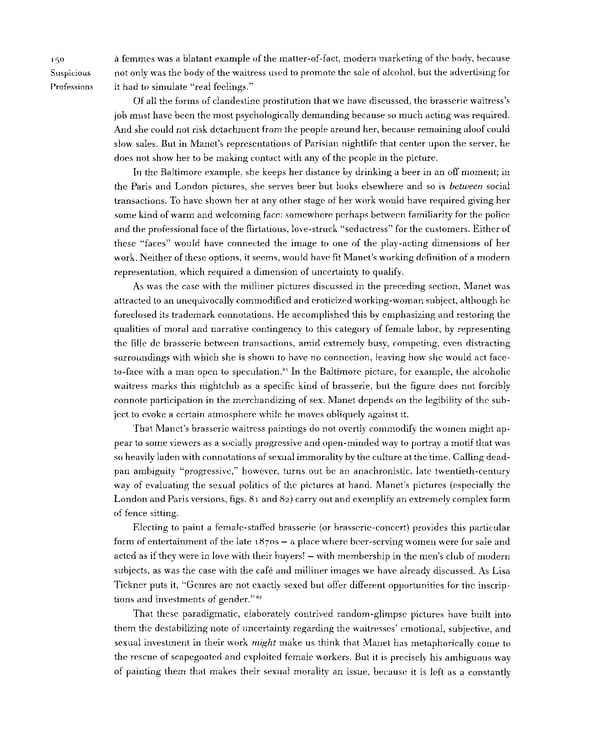150 a femmes was a blatant example of the matter-of-fact, modern marketing of the body, because Suspicious not only was the body of the waitress used to promote the sale of alcohol, but the advertising for Professions it had to simulate "real feelings." Of all the forms of clandestine prostitution that we have discussed, the brasserie waitress's job must have been the most psychologically demanding because so much acting was required. And she could not risk detachment from the people around her, because remaining aloof could slow sales. But in Manet's representations of Parisian nightlife that center upon the server, he does not show her to be making contact with any of the people in the picture. In the Baltimore example, she keeps her distance by drinking a beer in an off moment; in the Paris and London pictures, she serves beer but looks elsewhere and so is between social transactions. To have shown her at any other stage of her work would have required giving her some kind of warm and welcoming face: somewhere perhaps between familiarity for the police and the professional face of the flirtatious, love-struck "seductress" for the customers. Either of these "faces" would have connected the image to one of the play-acting dimensions of her work. Neither of these options, it seems, would have fit Manet's working definition of a modern representation, which required a dimension of uncertainty to qualify. As was the case with the milliner pictures discussed in the preceding section, Manet was attracted to an unequivocally commodified and eroticized working-woman subject, although he foreclosed its trademark connotations. He accomplished this by emphasizing and restoring the qualities of moral and narrative contingency to this category of female labor, by representing the fille de brasserie between transactions, amid extremely busy, competing, even distracting surroundings with which she is shown to have no connection, leaving how she would act face- 81 to-face with a man open to speculation. In the Baltimore picture, for example, the alcoholic waitress marks this nightclub as a specific kind of brasserie, but the figure does not forcibly connote participation in the merchandizing of sex. Manet depends on the legibility of the sub- ject to evoke a certain atmosphere while he moves obliquely against it. That Manet's brasserie waitress paintings do not overtly commodify the women might ap- pear to some viewers as a socially progressive and open-minded way to portray a motif that was so heavily laden with connotations of sexual immorality by the culture at the time. Calling dead- pan ambiguity "progressive," however, turns out be an anachronistic, late twentieth-century way of evaluating the sexual politics of the pictures at hand. Manet's pictures (especially the London and Paris versions, figs. 81 and 82) carry out and exemplify an extremely complex form of fence sitting. Electing to paint a female-staffed brasserie (or brasserie-concert) provides this particular form of entertainment of the late 18705 — a place where beer-serving women were for sale and acted as if they were in love with their buyers! - with membership in the men's club of modern subjects, as was the case with the cafe and milliner images we have already discussed. As Lisa Tickner puts it, "Genres are not exactly sexed but offer different opportunities for the inscrip- 82 tions and investments of gender." That these paradigmatic, elaborately contrived random-glimpse pictures have built into them the destabilizing note of uncertainty regarding the waitresses' emotional, subjective, and sexual investment in their work might make us think that Manet has metaphorically come to the rescue of scapegoated and exploited female workers. But it is precisely his ambiguous way of painting them that makes their sexual morality an issue, because it is left as a constantly
 Prostitution & Impressionists Page 170 Page 172
Prostitution & Impressionists Page 170 Page 172